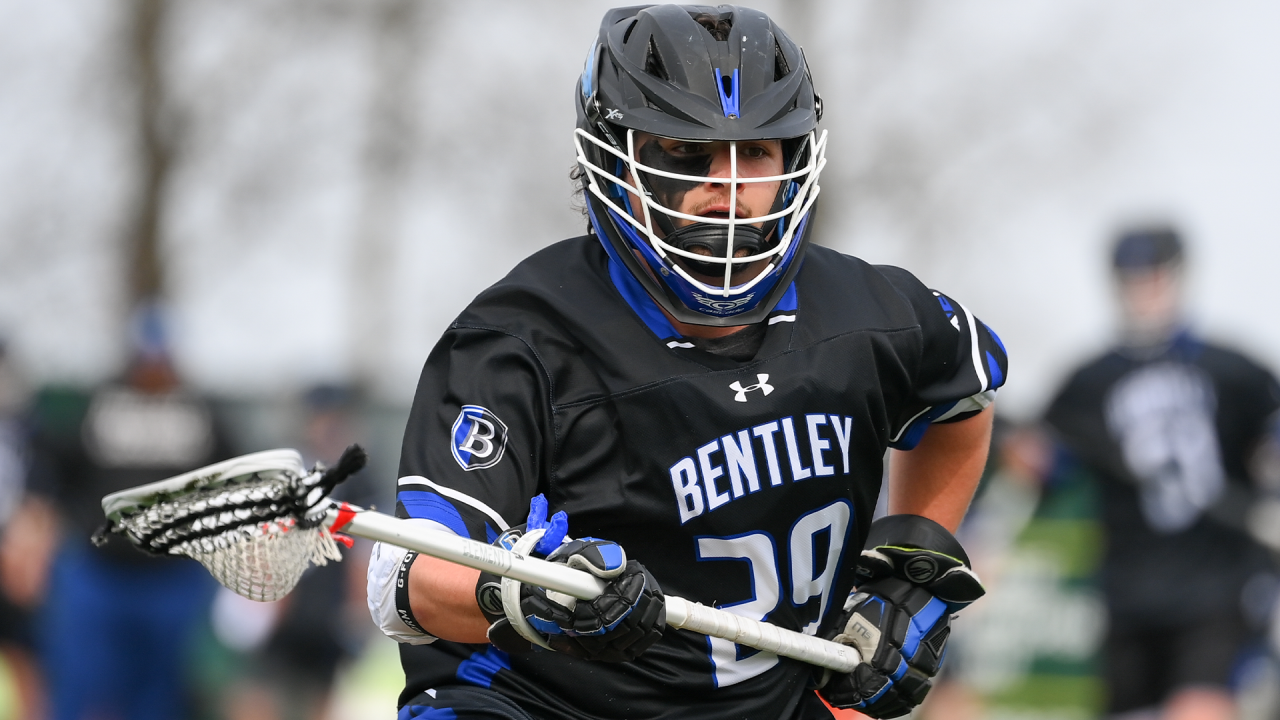
Beyond the Basics: Advanced Metrics That Define Every D-II Men's Top 20 Team
Lacrosse Reference goes beyond the box score. Beyond the basics, if you will.
Lacrosse Reference was created in 2016 with the goal of bringing the analytical methods used in other sports to college lacrosse. The site’s focus has been on finding innovative ways to compare teams and players that are more nuanced than the broad-brush metrics that were common at the time.
Analytics expert and Lacrosse Reference founder Zack Capozzi is back ahead of the Division II men’s season to provide insights on one advanced metric per Top 20 team.
For a glossary of terms, head here.
1. Lenoir-Rhyne
The departure of offensive powerhouses, including Toron Eccleston, has left Lenoir-Rhyne with just 44% of last season’s offensive production, signaling a transitional phase that could test the team’s adaptability. While the Bears have experience with 20 upperclassmen on the roster, the pressure is on for emerging talents like Evan Voss and Will Canata to step up. And not just take over the touches, but try and match the efficiency ratings that their predecessors managed. The offensive unit’s ability to recalibrate will be pivotal in maintaining Lenoir-Rhyne’s edge.
2. Adelphi
Adelphi’s defense was a very efficient unit, ranking 5th in the nation when adjusted for the quality of the offenses faced. The Panthers’ success hinged on their ability to disrupt what their opponents were trying to do; their best stretch of four games saw them produce a turnover rate of 45%. However, over the four games when their turnover creation dipped to 34%, their defensive efficiency fell off, too. During this stretch, their efficiency was that of the 62nd-best defense. We’ll see whether the 2024 team is as turnover-dependent as last season.
3. Limestone
Limestone’s offense is bringing back 93% of production from 2023, which speaks volumes about the Saints’ potential. With players like Mike McGarry and Zachary Terry, who put up individual efficiency ratings in the 79th and 82nd percentiles, respectively, the team’s offensive consistency is a clear strength. This continuity, combined with their previous season’s national ranking in the 84th percentile for opponent-adjusted offensive efficiency, suggests more good offense is on the horizon.
4. Wingate
With a schedule that is projected as the toughest non-conference slate in the nation and overall the 7th-most difficult, Wingate is set to face a real murderer’s row in the 2024 season. This approach not only tests the team’s mettle but also positions the Bulldogs favorably for postseason selection, given the importance of strength-of-schedule in ranking considerations. Last year’s non-conference slate was ranked 5th, but they replaced Barton and UIndy with Maryville, Florida Southern and Tampa.
5. Rollins
With a deep roster and the return of 89% of the offensive output, Rollins has the potential to take a step forward, especially if new players stepping into larger roles can deal with the increased attention and maintain, or even improve, their efficiency. William Metz is a loss, as he generated 8% of the team’s assists, but Berkman, Hansen and Johnstone are a solid core to build off. The floor for this unit is probably something close to the 95th percentile performance for opponent-adjusted efficiency they put together a year ago.
6. Tampa
It’s tough to separate the impact of the goalie from the impact of the defense as a whole when you are looking at save percentages. I like to look at shot-on-goal rates as a goalie-independent measure of how much pressure the defense is putting on the offense. That means if shot-on-goal rate isn’t popping out as an interesting metric and save percentage is, it’s more likely a goalie issue. And for Tampa, that’s what we see. In their best stretch, the Spartans’ defense looked like the top unit in the country, and their keepers saved 66% of the shots they faced. Their worst stretch? They played like a 5th percentile defense and their goalies only stopped 40% of the shots they saw.
7. Mercyhurst
Heading into the 2024 season, Mercyhurst faces the challenge of replacing key players, particularly at the faceoff dot, where the team returns only 20% of last year’s production. The departure of Shawn Doran and his outstanding 71.7% win rate leaves a significant void in a unit that was top notch, finishing in the 99th percentile nationally. How well players like Matthew Welch step into this role could be pivotal in maintaining the Lakers’ control over the game’s tempo and possession.
8. Saint Anselm
Saint Anselm’s offense is poised for a promising season, returning 97% of the offensive production. With key players like Jack Andrews and Noah Larsen capable of further refining their efficiency, which currently stands in the 65th and 51st percentiles, respectively, the team’s offensive unit, ranked in the 76th percentile, has a solid foundation to build on. This continuity, coupled with the potential for individual growth, suggests that Saint Anselm’s offense could be an even greater force in the upcoming season.
9. Mercy
The 2024 schedule for Mercy is a blend of challenges and opportunities, with LaxElo simulations forecasting a strong performance. The non-conference lineup, which projects as 11th-toughest, is designed to test the team’s mettle, while the conference games offer a chance to consolidate victories. Keep an eye on their toughest stretch between February 24 and March 10, when the Mavericks have four games against Bentley, Georgian Court, Adelphi and Seton Hill. If they can come away with a 4-0 record in this period, everything is on the table.
10. UIndy
The departure of Drew Billig gets the headlines, but UIndy’s defense is set to face perhaps a bigger test with only 36% of last year’s defensive contributions returning for a team that finished 2023 in the 89th percentile for defensive efficiency. The loss of veteran defender Josh Jackson stings. Having KC Carlson and his 49% save percentage back in net at least provides continuity between the pipes, but it may take some time for the defense in front of him to get comfortable together.
11. Florida Southern
The returning faceoff duo of Jacob Czyz and Luke Henricksen, who took 63% and 34% of the draws, respectively, with a 54% win rate each, provides a solid foundation for Florida Southern. The performance of this unit, which was in the 59th percentile last season, is a key area that could help tilt the field, giving the Moccasins the chance to control the flow of the game. If Czyz and Henricksen can elevate their game, they may become a significant tailwind for the Mocs’ overall team success.
12. Bentley
Conor Segreti’s shooting efficiency proved to be a significant barometer for Bentley’s offensive effectiveness. During Segreti’s most efficient stretch, his shooting efficiency climbed to the 88th percentile, correlating with a 4-0 run for the team. In contrast, when his efficiency dipped to the 17th percentile over four games, the team’s record was less dominant at 3-1. With Luke Jaber off to Providence, the question for Bentley is whether it will be able to weather a rough stretch from Segreti this year.
13. Colorado Mesa
Despite losing a key offensive player in AJ Switzer, Colorado Mesa’s offense is poised for continuity, with Drew Eickelman ready to take on a larger role after ranking in the 71st percentile for individual efficiency. His ability to step up will be crucial for an offense that was in the 92nd percentile nationally. The team’s success will hinge on how well it can reshuffle personnel and how well those players handle the extra defensive glare that Switzer shouldered a season ago. The 92nd percentile is a tough standard to uphold.
14. Pace
Pace’s offensive lineup faces a challenging rebuild after losing Caputo, Veres, Brown and Ottaviano. All told, the Setters return just 50% of the overall offensive production (measured by offensive EGA). However, the potential for growth lies with players like Daniel Zabbia and Rafael Rodriguez Jr., who have shown promise with individual efficiency ratings in the 53rd and 86th percentiles, respectively. Their development will be crucial for Pace to maintain or surpass its previous opponent-adjusted offensive ranking in the 71st percentile.
15. Seton Hill
The departure of goalie Josh Miller, who had a save percentage just shy of 55%, poses a significant challenge for Seton Hill’s defense. With Andrew D’Allaird’s 2023 save percentage at 46.2% (in limited action), the Griffins’ goalkeeping responsibilities now hinge on his development or the potential rise of a freshman like Cam Rohrer. Addressing this gap is crucial for Seton Hill to maintain the defensive effectiveness that saw the Griffins finish in the 90th percentile for opponent-adjusted efficiency last season.
16. Frostburg State
Did Frostburg win? Tell me how many goals Owen McCallum scored, and I’ll tell you. In games against conference peers and similarly ranked teams, when McCallum hit the back of the net at least three times, Frostburg went 5-0. If he scored two or fewer, Frostburg went 0-4. And it wasn’t just the scoreboard; the offense worked better when he was more involved. The Bobcats scored on 44% of their possessions in games when he scored three or more versus just 28% when he was below that mark.
17. Newberry
Scott Reed’s transformation into a dual-threat offensive player for Newberry is highlighted by his improvement in both shooting efficiency and assist rate. With a shooting efficiency rating of 93 and an increase in his share of the team’s assists from 9.2% to 14.7%, Reed’s development was huge for Newberry’s offensive dynamic, and the Wolves finished the year as the 13th-best opponent-adjusted offense in the country.
18. Barton
The key metric for Barton’s offense was the assist-to-turnover ratio. When Barton’s assist-to-turnover ratio exceeded 0.80 (so four assists for every five turnovers), the Bulldogs were a perfect 5-0. When they had fewer assists or more turnovers, their record was 2-3. Nothing was more important to Barton’s chances of winning than crisp ball movement and good decision making from its initiators.
19. Lewis
Zach Buddelmeyer, with a shooting efficiency in the 58th percentile and 10.4% of the team’s total shots, showed signs of becoming a key offensive player for Lewis. His development trajectory, reminiscent of Zach Rozgonyi (Florida Tech), suggests that with improvements in ball security and assist rate, Buddelmeyer could substantially elevate the Flyers’ offensive capabilities.
20. Belmont Abbey
Defense was the strength for Belmont Abbey last year. After adjusting for the strength of the Crusaders’ opponents, they finished the year as the 23rd-ranked defense in the country. Not only was the defense good, but it was the fulcrum on which their season rested. In their 10 victories, their average adjusted defensive efficiency was 21.9% (roughly one goal for every five possessions faced). In their five defeats, it ballooned up to 31.4%.
Zack Capozzi
Zack Capozzi's career peaked when he scored a goal in a men's league game against a defense that had a guy wearing a Delaware helmet. He (smartly) ended his playing career and now runs LacrosseReference.com where he uses numbers to uncover the hidden stories of college lacrosse.

Categories
Related Articles




